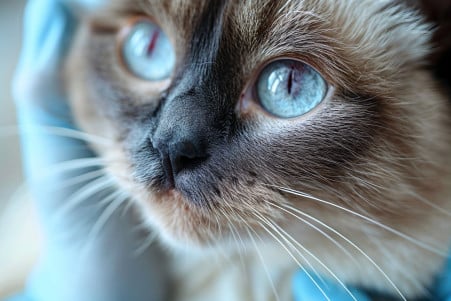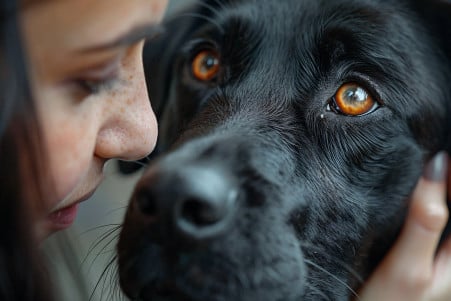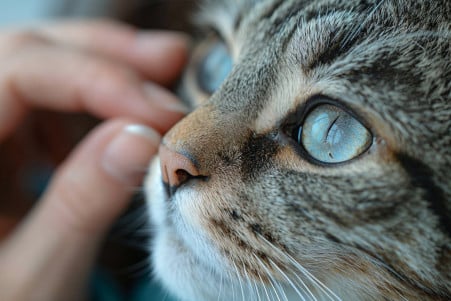Hazy Eyes in Cats: Causes and Treatment Options
29 February 2024 • Updated 29 February 2024

Hazy eyes in cats can be a sign of an underlying health issue. Hazy eyes in cats can be a sign of cataracts, corneal ulcers, or glaucoma, all of which can be a sign of a larger health issue.
It’s important for these issues to be diagnosed and treated by a vet as soon as possible so that they can be managed and so that your cat doesn’t experience vision loss or other issues.
This article will explore a variety of studies from veterinary medicine, ophthalmology, and animal nutrition to help explain the causes and effects of hazy eyes in cats. By looking at peer-reviewed research, expert opinions, and in-depth summaries from animal health publications, we hope to give you a comprehensive understanding of this issue. Our goal is to help cat owners better understand this issue so that they can make the best decisions for their pets.
What causes hazy eyes in cats and what are the treatment options?
How to Tell If Your Cat Has Cloudy Eyes: Signs and Symptoms
For pet owners, the most obvious sign that a cat has cloudy eyes is that the cat’s eyes no longer look clear and bright. Signs of cloudy eyes in cats include a milky or opaque appearance. However, there are also behavioral signs that may indicate the condition, such as excessive eye rubbing, disorientation, and an increased sensitivity to light.
According to Wag! Walking, other signs to look for include squinting, rapid blinking, and discharge from the eyes, all of which could be symptoms of eye conditions like corneal ulceration, keratitis, cataracts, and glaucoma.
If you notice any of these signs, it’s important to get your cat to the vet as soon as possible. According to Vetster, the diagnostic process may involve a physical and ophthalmic exam, which may include using a corneal stain to detect damage, tonometry to measure intraocular pressure, and other tests to ensure an accurate diagnosis.
A quick and accurate diagnosis is important for managing and treating the condition effectively. Since the cost and complexity of treatments for cloudy eyes can vary, it may be helpful to consider options like pet insurance, as Puainta explains, to help cover the cost of veterinary care.
By understanding the signs and symptoms of cloudy eyes and the importance of getting your cat to the vet for a proper diagnosis, you can make sure you’re doing everything you can to protect your cat’s vision and health.
Cutting Through the Fog: What Causes Cloudy Eyes in Cats?
Cloudy eyes in cats can be caused by a range of health problems, some more serious than others. Infections, inflammation, and physical trauma to the eye can all cause the eye to become cloudy.
According to PetMD, conditions like cataracts, which is an opacity of the lens, and corneal ulcers, which are essentially scratches on the cornea, can cause the eye to become cloudy and impair a cat’s vision. Glaucoma, which is the most serious of these conditions, is an eye condition that causes increased pressure in the eye, making these conditions worse and potentially leading to permanent blindness.
In addition, systemic diseases like diabetes or hypertension can cause ocular symptoms, including cloudy eyes, and can even cause damage to the retina. According to veterinarians in South Florida, while conditions like cataracts in cats can be genetic or age-related, other conditions can be a sign of a more serious health problem that needs to be addressed immediately.
In addition, while it’s less common, congenital defects or nutritional deficiencies can also cause cloudy eyes in cats. It’s important to note that while some of these conditions can be treated if they’re caught early, if they’re left untreated, the damage can be permanent. Knowing what to look for can help you catch these conditions early and ensure that your cat gets the treatment they need.
Getting Rid of the Fog: How to Treat Cloudy Eyes in Cats
Unfortunately, there is no one-size-fits-all approach to treating cloudy eyes in cats. As our South Florida vets explain, the treatment for cloudy eyes will depend on the specific cause, and can range from medical management to surgical intervention. For example, infections or inflammation that are the result of conditions like keratitis or uveitis can be treated with antibiotics or anti-inflammatory medications, while viral infections like feline herpesvirus can be treated with antiviral medications.
If cataracts are causing a cat to lose their vision, cataract surgery can be performed to restore their sight, but it’s important to consult with a veterinary ophthalmologist to determine if the cat is a good candidate, according to Puainta®. Vets will also want to ensure that the cat receives the proper post-surgical care and monitoring to ensure they recover well and don’t experience any complications.
In addition to medical treatment, supportive care is also important in managing and helping cats recover from eye issues. Regularly cleaning the eyes, ensuring that the cat is eating a balanced diet, and making sure that the cat’s environment is safe can all help the cat heal and avoid further damage.
The prognosis for a cat’s recovery will depend on how advanced the condition is and how quickly treatment is started. However, with early intervention and the right care, many cats can see a significant improvement in their eye health and overall quality of life.
Protecting Your Cat’s Eyes: How to Avoid Cataracts and Other Eye Conditions
To avoid cataracts and other eye conditions, make sure to clean your cat’s eyes regularly and use protective measures when necessary, especially if your cat spends a lot of time in the sun or outdoors. In addition, a diet that’s rich in antioxidants is important for keeping your cat’s eyes healthy. Antioxidants can help prevent the damage that can lead to cataracts, according to Daily Paws.
In addition, regular vet visits are important for catching and preventing eye problems. During these visits, vets can catch and treat eye issues early, which can help prevent more serious problems from developing. Keeping your home safe and free from hazards can also help prevent eye injuries and keep your cat’s vision safe.
In addition, make sure to keep up with vaccinations and other preventive care to help reduce the risk of infectious diseases that can lead to eye problems, including those caused by the feline herpes virus, according to Northwest Animal Eye Specialists. By doing these things, you can help ensure that your cat’s eyes stay healthy and that they can continue to see the world around them for years to come.
Seeing Through the Fog: Cat Eye Health in Review
As noted by PetMD, there are many potential causes of cloudy eyes in cats, from corneal ulcers to more serious issues like glaucoma and cataracts.
No matter the cause, it’s important to note that symptoms like squinting, discharge, and cloudiness are all signs that you need to take your cat to the vet.
The many potential causes of cloudy eyes, as noted by Wag! Walking., show that it’s important to catch these issues early and that there are many different ways to treat these issues, including medications and surgeries that can be tailored to the specific cause of the problem.
That said, many of these issues can be avoided with proper care. Regular check-ups, cleaning, and protecting your cat’s eyes from injury are all important parts of maintaining their eye health. Not to mention, catching and treating cloudy eyes early can also be an important part of maintaining your cat’s overall health, as many of the issues that cause cloudy eyes can also cause other health problems.
This is all to say that it’s important to know about and prioritize cat eye health. Being aware of the issue and acting quickly can make a big difference in your cat’s vision and quality of life.


